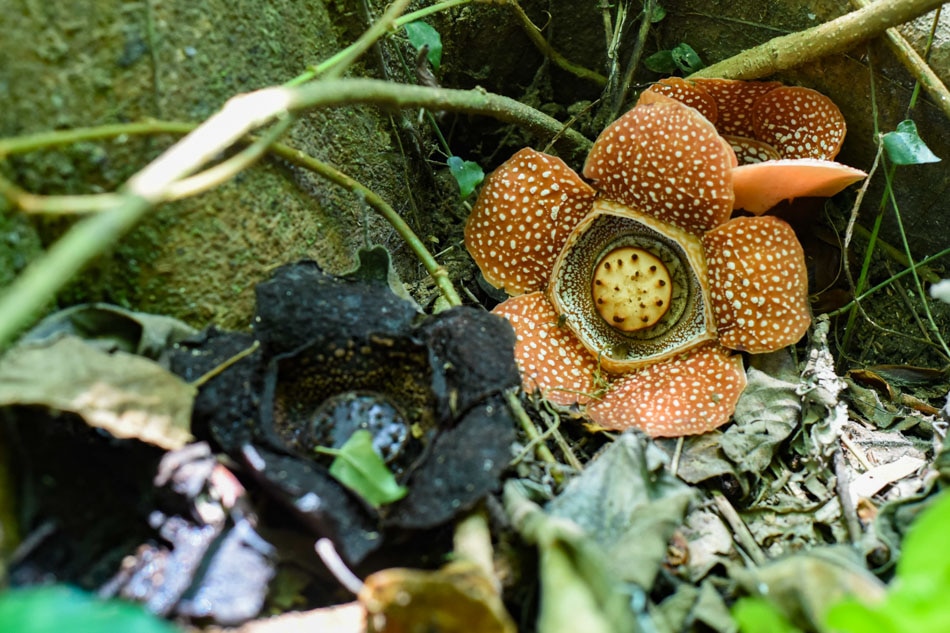Most species of 'world's largest flower' risk extinction: study | ABS-CBN
ADVERTISEMENT

Welcome, Kapamilya! We use cookies to improve your browsing experience. Continuing to use this site means you agree to our use of cookies. Tell me more!
Most species of 'world's largest flower' risk extinction: study
Most species of 'world's largest flower' risk extinction: study
Agence France-Presse
Published Sep 21, 2023 04:44 PM PHT
BANGKOK, Thailand — Most species of the famously large Rafflesia flower, which has long captured the imagination with its enormous speckled red petals, are now at risk of extinction, new research has warned.
BANGKOK, Thailand — Most species of the famously large Rafflesia flower, which has long captured the imagination with its enormous speckled red petals, are now at risk of extinction, new research has warned.
Rge Rafflesia is actually a parasite, and lives on tropical vines across parts of Southeast Asia, producing blooms that are among the largest in the world.
Rge Rafflesia is actually a parasite, and lives on tropical vines across parts of Southeast Asia, producing blooms that are among the largest in the world.
It is something of an enigma, with its flowers emerging unpredictably, and botanists have had limited success propagating it outside its natural environment.
It is something of an enigma, with its flowers emerging unpredictably, and botanists have had limited success propagating it outside its natural environment.
One species of the flower is currently classed as "critically endangered," according to the International Union for Conservation of Nature.
One species of the flower is currently classed as "critically endangered," according to the International Union for Conservation of Nature.
ADVERTISEMENT
To better understand the plant and its conservation status, an international group of botanists examined 42 known Rafflesia species and their habitats -- primarily Brunei, Indonesia, Malaysia, the Philippines, and Thailand.
To better understand the plant and its conservation status, an international group of botanists examined 42 known Rafflesia species and their habitats -- primarily Brunei, Indonesia, Malaysia, the Philippines, and Thailand.
Based on the rapid disappearance of its forest habitats, as well as insufficient conservation strategies and protection plans, the plant is at far greater risk than previously known, they said.
Based on the rapid disappearance of its forest habitats, as well as insufficient conservation strategies and protection plans, the plant is at far greater risk than previously known, they said.
"We estimate that 60 percent of Rafflesia species face a severe risk of extinction," the researchers wrote in the study, published Wednesday in the peer-reviewed Plants, People, Planet journal.
"We estimate that 60 percent of Rafflesia species face a severe risk of extinction," the researchers wrote in the study, published Wednesday in the peer-reviewed Plants, People, Planet journal.
Some species risk going extinct before they are even known to science, the study said, urging more research into the unusual plant.
Some species risk going extinct before they are even known to science, the study said, urging more research into the unusual plant.
"We urgently need a joined-up, cross-regional approach to save some of the world's most remarkable flowers, most of which are now on the brink of being lost," said Chris Thorogood, deputy director of Oxford University's Botanical Garden and a study author.
"We urgently need a joined-up, cross-regional approach to save some of the world's most remarkable flowers, most of which are now on the brink of being lost," said Chris Thorogood, deputy director of Oxford University's Botanical Garden and a study author.
The research points out that the plant is believed to grow in fairly limited areas, making it particularly vulnerable to habitat destruction.
The research points out that the plant is believed to grow in fairly limited areas, making it particularly vulnerable to habitat destruction.
It also highlights several bright spots in conservation efforts, including successful propagation at a botanical garden in Indonesia's West Java, and sustainable ecotourism around the plant in West Sumatra.
It also highlights several bright spots in conservation efforts, including successful propagation at a botanical garden in Indonesia's West Java, and sustainable ecotourism around the plant in West Sumatra.
Last year, nations pledged to protect 30 percent of the world's land and seas by 2030 in a landmark deal to slow the disappearance of species and ecosystems.
Last year, nations pledged to protect 30 percent of the world's land and seas by 2030 in a landmark deal to slow the disappearance of species and ecosystems.
Repeated studies have warned that the twin threats of climate change and environmental destruction caused by humans are dramatically reducing biodiversity worldwide.
Repeated studies have warned that the twin threats of climate change and environmental destruction caused by humans are dramatically reducing biodiversity worldwide.
Read More:
Rafflesia
extinction
world's largest flower
flower
International Union for Conservation of Nature
Plants
People
Planet journal
Oxford University Botanical Garden
Rafflesia species
ADVERTISEMENT
ADVERTISEMENT



